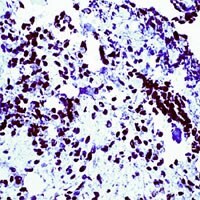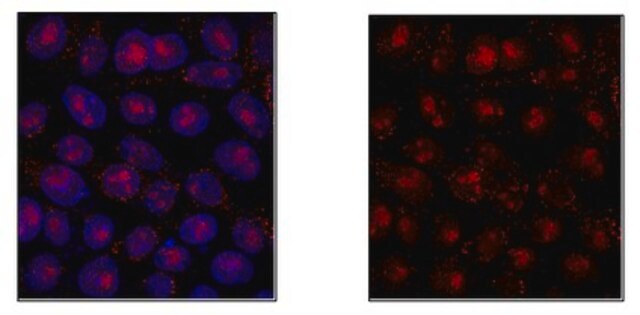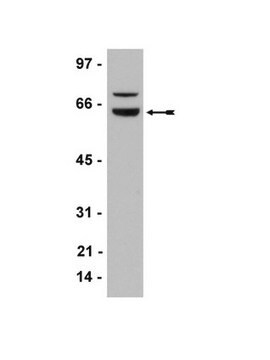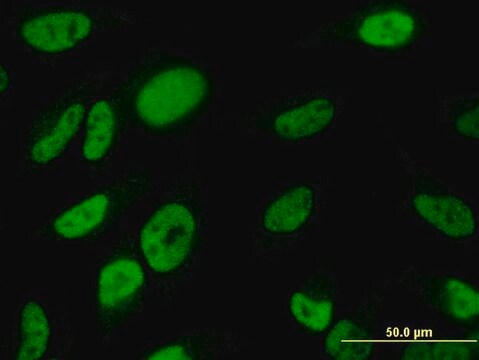おすすめの製品
詳細
Immunoaffinity purified rabbit polyclonal antibody. Recognizes the ~47-55 kDa Wilm′s tumor protein.
Recognizes the ~47-55 kDa Wilm′s tumor protein in Wilm′s tumor tissue.
This Anti-Wilm′s Tumor Protein Rabbit pAb is validated for use in Immunoblotting, Paraffin Sections, Immunoprecipitation for the detection of Wilm′s Tumor Protein.
免疫原
Human
a synthetic peptide corresponding to amino acids from the C-terminus of human Wilm′s tumor protein
アプリケーション

Immunoblotting (see comments)
Paraffin Sections (1:100, heat pre-treatment required)
Immunoprecipitation (see comments)
包装
Please refer to vial label for lot-specific concentration.
警告
Toxicity: Standard Handling (A)
物理的形状
In 10 mM PBS, 0.2% BSA, pH 7.6.
再構成
Following initial use, aliquot and freeze (-20°C) for long-term storage.
アナリシスノート
Positive Control
Wilm′s tumor tissue
Wilm′s tumor tissue
その他情報
Huff, V. 1998. Am. J. Med. Genet.79, 260.
Staining of formalin-fixed, paraffin-embedded tissues requires antigen retrieval by boiling tissue sections in 10 mM citrate buffer, pH 6.0 for 10-20 min, followed by cooling at room temp for 20 min. This antibody is also reported to work for immunoblotting and immunoprecipitation. Antibody should be titrated for optimal results in individual systems.
法的情報
CALBIOCHEM is a registered trademark of Merck KGaA, Darmstadt, Germany
適切な製品が見つかりませんか。
製品選択ツール.をお試しください
保管分類コード
10 - Combustible liquids
WGK
WGK 1
引火点(°F)
Not applicable
引火点(℃)
Not applicable
適用法令
試験研究用途を考慮した関連法令を主に挙げております。化学物質以外については、一部の情報のみ提供しています。 製品を安全かつ合法的に使用することは、使用者の義務です。最新情報により修正される場合があります。WEBの反映には時間を要することがあるため、適宜SDSをご参照ください。
Jan Code
CA1026-UL:
CA1026-50UL:
試験成績書(COA)
製品のロット番号・バッチ番号を入力して、試験成績書(COA) を検索できます。ロット番号・バッチ番号は、製品ラベルに「Lot」または「Batch」に続いて記載されています。
Noortje A M Bax et al.
Developmental dynamics : an official publication of the American Association of Anatomists, 239(8), 2307-2317 (2010-07-27)
Platelet-derived growth factor receptor alpha (Pdgfralpha) identifies cardiac progenitor cells in the posterior part of the second heart field. We aim to elucidate the role of Pdgfralpha in this region. Hearts of Pdgfralpha-deficient mouse embryos (E9.5-E14.5) showed cardiac malformations consisting
Caitlin M Braitsch et al.
Journal of molecular and cellular cardiology, 65, 108-119 (2013-10-22)
During embryonic heart development, the transcription factors Tcf21, Wt1, and Tbx18 regulate activation and differentiation of epicardium-derived cells, including fibroblast lineages. Expression of these epicardial progenitor factors and localization of cardiac fibrosis were examined in mouse models of cardiovascular disease
Noortje A M Bax et al.
Developmental dynamics : an official publication of the American Association of Anatomists, 238(10), 2658-2669 (2009-08-26)
For the establishment of a fully functional septated heart, addition of myocardium from second heart field-derived structures is important. Platelet-derived growth factors (PDGFs) are known for their role in cardiovascular development. In this study, we aim to elucidate this role
Timo H Lüdtke et al.
American journal of physiology. Lung cellular and molecular physiology, 316(5), L767-L783 (2019-02-01)
The mesothelial lining of the lung, the visceral pleura, and of the heart, the epicardium, derive from a common multipotent precursor tissue, the mesothelium of the embryonic thoracic cavity that also contributes to organ-specific mesenchymal cell types. Insight into mesothelial
Parisa Ranjzad et al.
Nephron, 144(10), 509-524 (2020-08-07)
Numerous studies have documented the in vitro differentiation of human pluripotent stem cells (hPSCs) into kidney cells. Fewer studies have followed the fates of such kidney precursor cells (KPCs) inside animals, a more life-like setting. Here, we tested the hypothesis
ライフサイエンス、有機合成、材料科学、クロマトグラフィー、分析など、あらゆる分野の研究に経験のあるメンバーがおります。.
製品に関するお問い合わせはこちら(テクニカルサービス)







